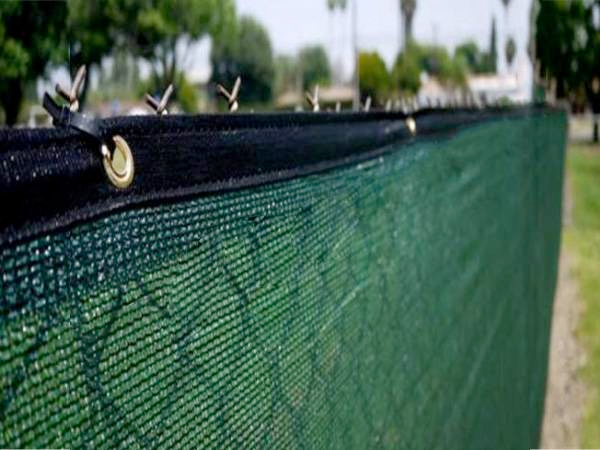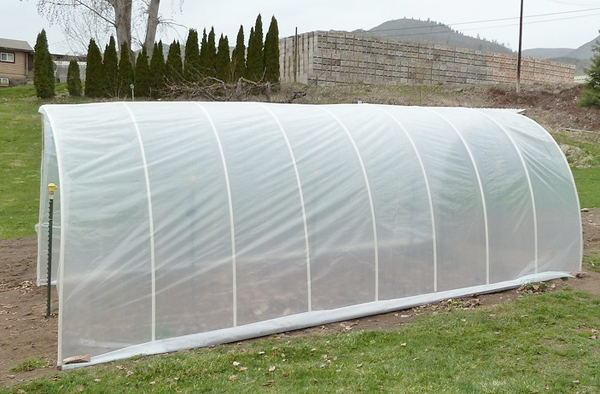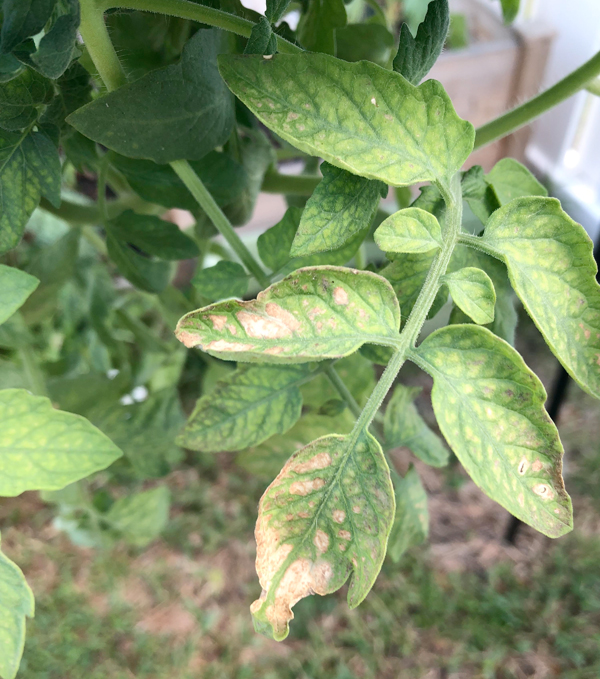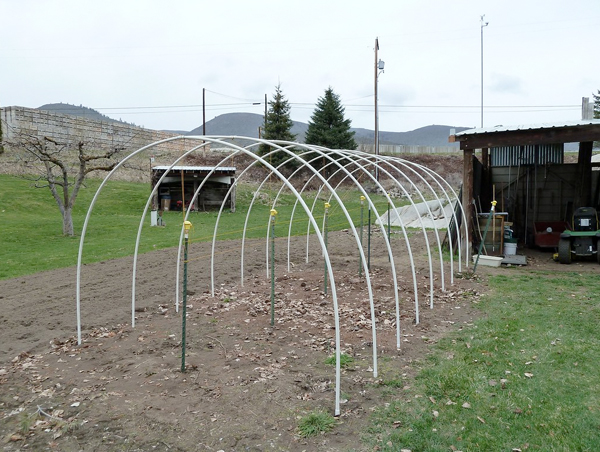
Chapter 10
Protecting Your Plants
When you move your tomatoes outside, you should always consider giving them some kind of protection no matter how well you have hardened them off. Also, you need to pay close attention to the weather predictions for your area. If you are intentionally planting before all danger of frost has passed, or if it is windy in your area, or if you are concerned about the sun being too strong, you should set up a black plastic windbreak around your tomato plants for their first few weeks in the garden. This applies even if all danger of frost has passed. This barrier will help protect your plants from cold weather, wind, and direct sunlight. It gives them an additional opportunity to adapt to their new environment. A good start without setbacks is important.

Protection becomes even more important the earlier the plants are placed outside. Early starts are not without risk. The amount of protection you will need depends on your particular weather and the amount of wind you experience at your growing site. Every garden is different as is every growing season. It is always better to be safe than sorry. If you have decided to use a Wall o' Water as your means of plant protection, that might be all you need depending on the size of your plants. Gordon Graham used these and stacked them two high, but he planted outside very early in the season. He used row cover material for additional protection as well.

Later in the season as the tomatoes grow, those tomatoes exposed directly to sunlight may develop sunscald. This will cause the exposed tomatoes to stop growing and to ripen prematurely resulting in smaller tomatoes, not desirable for those wanting to go big. Small green tomatoes exposed to too much sun whiten and die. This is one reason it was suggested earlier that you allow suckers to develop leaves before terminating them. These leaves protect the tomatoes and stems from damaging direct sunlight. You may also protect your exposed tomatoes from the sun by using large paper plates or pieces of cloth as a shield.
Finally, as your tomato matures and is about to be harvested, there is the danger that a sudden large amount of water, as might occur with a heavy rainfall, might cause your tomato to suddenly expand and crack open. The way to avoid this is to cover the ground around the plant with plastic to prevent excess moisture from entering the soil. Cracks due to excessive water occur most commonly around the time of harvest and can severely damage your big tomato just before a weigh-off. It would be a shame to have your biggest tomato burst open as you are about to harvest it, because of too much water.

Using High Tunnels
High tunnels are structures constructed of a metal, wooden or PVC frame covered by a single layer of 6 mil plastic, or, if you want to have more control over how much sun your tomato plants get, a shade cloth. Most tunnels have high ceilings, compared to greenhouses, which allow gardeners to work inside the tunnel even in bad weather. High tunnels differ from greenhouses in that the plants usually are grown directly in the soil. Also, there is no permanent heating, air conditioning or exhaust fan involved. A grower may close and heat the tunnels in early spring and fall when outside temperatures drop. They can be ventilated during hot weather by rolling up the plastic sides of the tunnel and opening the ends to allow air to circulate. And, if necessary, an exhaust fan can be incorporated into the system.
There are many benefits to growing in a high tunnel. High tunnels provide protection from direct sunlight, rain, low temperatures, winds and hail. During those periods of time when air temperatures are high and too much direct sunlight can damage your tomato plants, they are sheltered by the plastic covering. The intensity of the sun governs the temperatures inside a high tunnel. It will be cooler inside a high tunnel on a cloudy day than on a sunny day, in the morning and evening than in the afternoon, and in the spring and fall than in the summer. Temperatures in a high tunnel can reach 120 degrees F. on a sunny day in July. But, not if the tunnel is well ventilated. Do whatever is necessary to keep the temperatures inside your tunnel from exceeding 85 degrees F.

Drip irrigation is very effective for watering plants in high tunnels. But, hand watering works well. Since the ground in a high tunnel is not subjected to precipitation, soluble salts can build up. Use soil tests to determine the fertility status of your soil.
My high tunnel has been a blessing to me. My tomato plants are no longer affected by huge downpours of rain or hail or high winds. My tomato plants do not get overheated from intense sun. Shade cloths are very helpful in gardening but a high tunnel is even better though a bit more costly.
Tomatoes should be protected from temperatures much greater than 90°F. They will be stressed when temperatures rise to 95°F and some will die in sustained temperatures greater than 110°F.

Signs of heat stress in tomatoes include wilting at the ends of new growth, blossom drop, leaf drop, and sunburn of leaves and fruit. Sunburn is characterized by dull yellow patches in the center of leaves and on fruit. These patches may turn white and thin as plant tissue dies.
Tomato plants begin to shut down by closing the stomata on the undersides of the leaves when the temperatures get above 85F in order to conserve water. This essentially turns off photosynthesis. The plant goes into a rest mode until the air temperature drops below 85F. When temperatures rise to greater than 95°F for more than a day or two tomatoes will stop growing and setting fruit.

In the event of high temperatures it is best to protect tomato plants from sun and heat. The best course of action is to keep direct sun off foliage and to lower the temperature of plants. The use of shade cloth can lower plant and soil temperatures by as much as 10°F.

Grower Comments on Plant Protection
"My last frost date is in mid-May, so I plant the end of May after all danger of frost is over. It can get very windy here well into June, so I also protect the plants when transplanted to the garden. I cut the bottom out of 5 gallon plastic buckets, then put them over the plants. They stay in place by being twisted into the soil about 3 inches. When the plants start growing out the top, they are big enough for the buckets to come off and the cages to go on." Ron K.
"After my plants come out of the cold frame and I transplant into the garden, I have to protect them because I live very close to the ocean and the wind can be brutal. I have some dog fence that I cut to size and form pieces into a circle. Then I cover this with plastic, and either tie cord around it or use clips or clothespins to fasten it. I use clothespins for so many things around the garden. This makes a nice miniature greenhouse without a cover, and it works fine and does the job. Once the warm weather is in full swing, I remove them. I use old fabric softener sheets to cover tomatoes on the plants that are exposed to the sun. If only one little spot gets sun scald, it will stunt the fruit's growth." Minnie Z.
"Early season protection is not an important consideration with our tomatoes, because the competition tomatoes are not started until June. The early season eating tomatoes are protected by a plastic wall until they become well established. The competition tomatoes are later protected by walls that were constructed for giant pumpkin early-season shelters. They consist of 5' x 5' panels attached to steel posts. Later in the season, plastic pipe is used to make ribs over the top of the shelter, and eventually clear plastic is rolled over the top and it becomes a greenhouse. This is how we keep tomatoes growing through September, and when it becomes cold during the night, an electric heater is used to hold the temperature above 60˚. In 2004, we entered some tomatoes that weighed over 4 pounds at a vegetable competition in November. This proved to be costly and too time consuming to bother trying again." Chris L.
"Whether or not I protect my plants depends on when I put them outside. Here, we plant tomatoes outside after the last frost date of June 1st. My plants are planted deep, so there is no concern about wind. Last year I built windbreaks around my tomatoes, but those without a windbreak did as well as those with. If my plants are in the ground, and it appears there might be a frost, I put large buckets over each plant. Putting tomato plants out early in our area just isn't worth the risk. Most of the contests take place from mid-August through early October, so an early start is of no real value. I am growing for size, not for the earliest edible tomato." Marv M.
"I am fortunate to live in a valley where much of the wind is shielded by homes to the south and southwest, and my neighbor on the west, where much of the wind comes from, has high brush to block the wind from that direction. Sometimes, I place 4 x 8 foot plywood or paneling on my garden fence which also blocks wind. I solid stake all my plants for additional help. On the north, where the cold fronts come in, I have an ample tree screen, and a stack of cut firewood piled about 30 feet from the garden to block winds. Trees, and a hillside on the east, complete a circular barrier against strong winds. I have used Wall-O-Waters in the past to get a quick start on early eating tomatoes. Since most tomato contests are from late September to October 1st, I've learned to start those tomatoes later in May when there is ample warmth. These plants seem to catch up quickly. I try to time my competition tomatoes 5 months from planting seed inside. For transplant protection, I use 5 gallon buckets, boxes, bushel baskets, etc." Don C.
"I grow my plants under full cover in either cold frames or green houses. If I didn't have early and late cover, I would have to quit growing." Eddie Z.
"My patch is approximately 65 to 70 feet long and 3 1/2' wide. I don't put any plants out until the end of May when the fear of frost is gone in my area. I also protect against wind and sun by encircling my planting area with 3 foot, 40% shade fabric. Since my plot is only 3 1/2' wide, this gives the tomato plants nice protection until they get well rooted and sturdy. Two bird feeders placed nearby keep the birds out of my 'maters'" Paul H.

